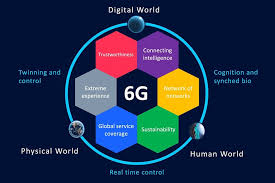6G Mobile Technology Explained: The Next Generation of Connectivity
telcomatraining.com – As the world continues to evolve toward a hyper-connected digital era, discussions about 6G mobile technology are gaining momentum. While 5G is still being deployed globally, researchers and tech innovators are already working on what comes next — 6G, the sixth generation of wireless communication. This next-generation technology promises to revolutionize how people, devices, and systems interact, unlocking possibilities that go far beyond the capabilities of today’s networks.
What Is 6G Technology?
6G refers to the sixth generation of mobile networks, expected to succeed 5G around 2030. It will provide ultra-fast, intelligent, and ubiquitous connectivity that integrates communication, sensing, and computing. Unlike 5G, which focuses on faster data speeds and low latency, 6G aims to create a seamless digital ecosystem where the physical and virtual worlds merge through technologies like artificial intelligence (AI), extended reality (XR), and holographic communication.
While 5G operates on millimeter-wave frequencies up to 100 GHz, 6G is projected to use terahertz (THz) frequencies, ranging from 100 GHz to 3 THz. This massive bandwidth expansion could theoretically allow data rates up to 1 terabit per second (Tbps) — about 100 times faster than 5G.
Key Features of 6G Mobile Networks
- Extreme Speed and Low Latency
6G networks are expected to deliver data speeds up to 1 Tbps with latency as low as 1 microsecond. This enables real-time communication for critical applications like autonomous vehicles, telesurgery, and industrial automation. - AI-Driven Networks
Artificial intelligence will be deeply embedded in the 6G infrastructure. Unlike 5G, which relies on human-managed networks, 6G systems will self-optimize using AI and machine learning, enhancing efficiency, reliability, and energy management. - Integration of Sensing and Communication
6G will combine communication with environmental sensing, allowing networks to detect objects, monitor movements, and analyze spatial data. This opens opportunities for smart cities, security systems, and next-level augmented reality experiences. - Global Connectivity
6G aims to bridge the digital divide by integrating satellite communication, high-altitude platforms, and terrestrial networks. This ensures global internet access, even in remote and rural areas.
The Technologies Powering 6G
To achieve its ambitious goals, 6G will rely on several cutting-edge technologies:
- Terahertz Waves: Enabling ultra-high data transmission rates.
- Reconfigurable Intelligent Surfaces (RIS): Enhancing signal coverage and quality.
- Quantum Communication: Providing unbreakable security.
- Edge AI Computing: Processing data closer to the user for faster response times.
These innovations will work together to create a smart, adaptive, and energy-efficient communication ecosystem.
Potential Applications of 6G
The applications of 6G extend far beyond smartphones. Imagine real-time holographic meetings, immersive metaverse experiences, and smart factories running entirely on automated systems. In healthcare, surgeons might perform remote operations with ultra-precise haptic feedback. Education could transform through virtual classrooms that feel as real as physical ones.
Additionally, autonomous vehicles and drone networks will rely on 6G to share instant data for safe and coordinated movement. The technology will also drive sustainability efforts by improving smart grid efficiency and environmental monitoring.
Challenges Ahead
Despite its promise, 6G faces several hurdles. The development of THz hardware, power efficiency, data privacy, and standardization are major challenges researchers must overcome. Moreover, deploying such an advanced network infrastructure will require massive investment and global cooperation between governments, telecom companies, and tech innovators.
The Future of Connectivity
6G represents more than just faster speeds — it symbolizes the next leap in human connectivity. By combining AI, quantum computing, and advanced sensing, 6G will pave the way for an intelligent, interconnected world. As we approach 2030, one thing is certain: the 6G mobile revolution will redefine how humanity communicates, learns, and creates in the digital age.







